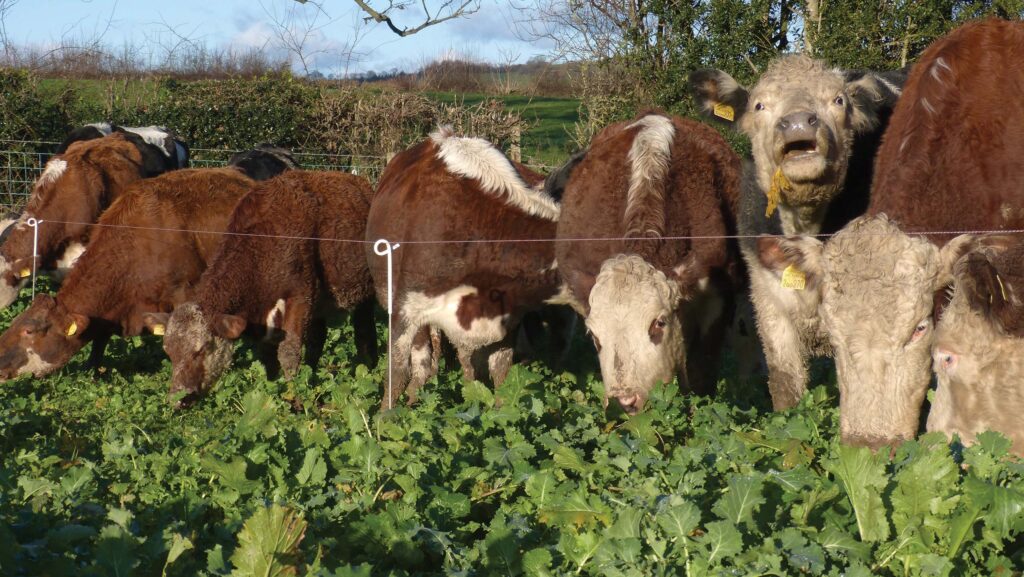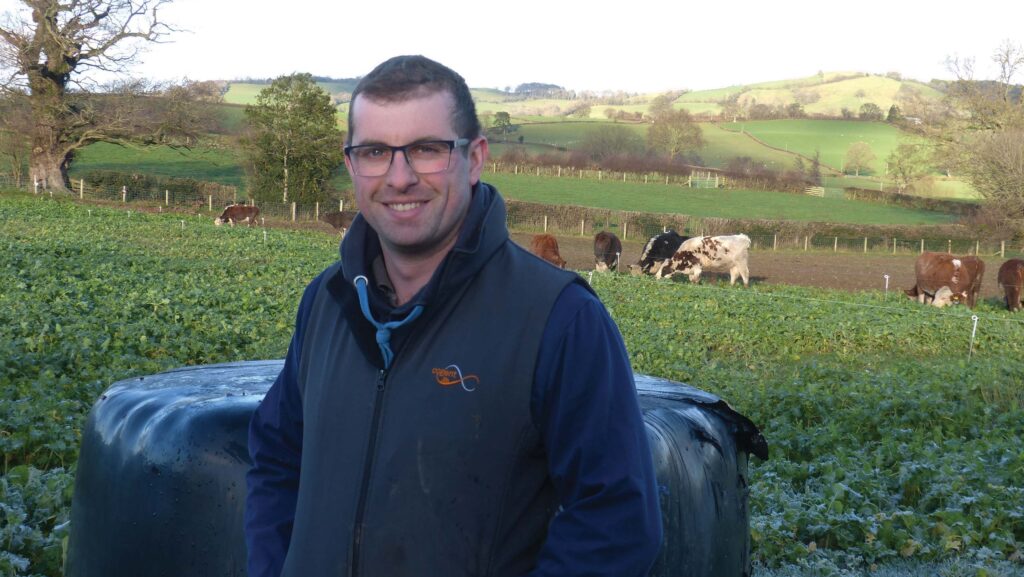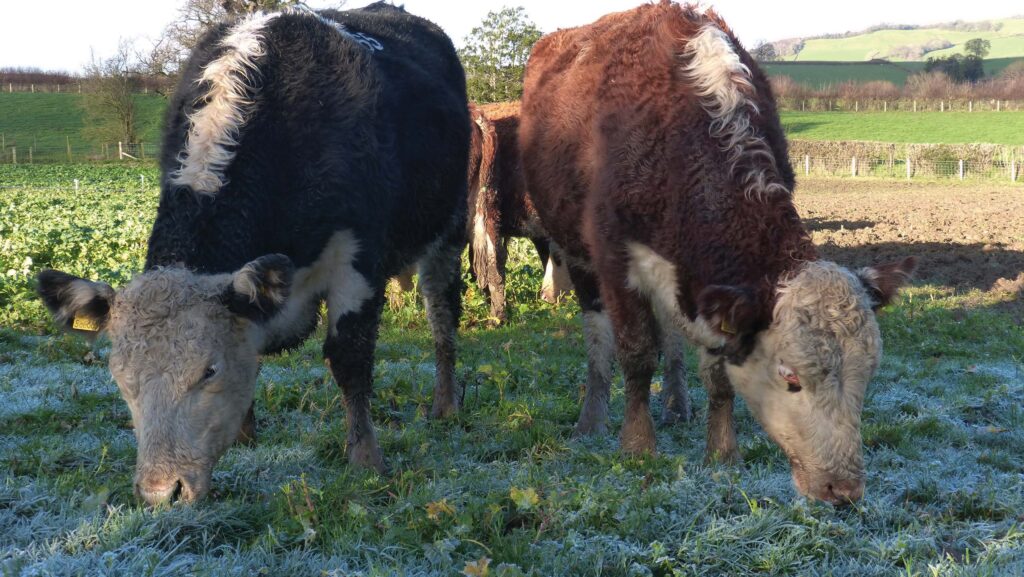Sheep and cattle new entrant shares 4 key lessons
 © MAG/Michael Priestley
© MAG/Michael Priestley A small grassland farm is turning profits from sheep, sucklers and dairy heifer rearing for a dairy breeding consultant come part-time farmer.
Tom Sellers runs a 25ha (62-acre) Powys County Council farm, with the help of family, friends and contractors, alongside working as UK fertility specialist for breeding company Cogent.
He moved to Penybryn, near Newtown, in November 2020, and gained a further 25ha (62 acres) on a two-year agreement with Powys council in 2024.
See also: Heifer rearing launch pad gets new entrant dairying
Although Tom is not from a farming background, he milked cows from age 14 and became a herd manager after studying agriculture at Walford College, Shrewsbury.
Roles followed as a farm manager, consultant and fertility-based training instructor.

Tom Sellers © MAG/Michael Priestley
Now 31, he believes anyone can get into farming.
“It’s about cost control while having a plan to produce something the market needs,” he says.
“And taking the opportunities as they arise, however small. Numerous people have helped me, and I can’t thank them enough.”
Farm Facts: Penybryn, Newtown, Powys
- Farming 68ha in total
- 25ha at Penybryn on 17-year farm business tenancy (FBT) running until 2037
- 25ha rented on two-year FBT in same parish, growing 10ha wheat this year
- 18ha of short-term grassland rents locally
System overview
Tom’s main enterprise is rearing dairy heifers. He has 70 contract heifers under his management at any time for one key client (Knolton House Farm), ranging from two-week-old calves to eight-month in-calf heifers calving as close to 24 months as possible.
He also bought 50 of his own calves and 15 bulling heifers last year to sell on as in-calf heifers.
A TB isolation unit is set up on the farm, allowing Tom to take TB-restricted calves from a single holding and get them clear with two 60-day tests.
Heifers paddock-graze permanent pasture and herbal leys.
They winter inside, either at Penybryn or on a local contractor’s farm (Phil Morgan Contracting) seven miles away at Church Stoke, where they are wintered on a bed-and-breakfast subcontract.
Trained in artificial insemination and pregnancy scanning, Tom serves heifers with a maximum of two shots of Cogent sexed dairy semen.
Heifers that fail to hold get a beef straw or are put to the Hereford stock bull. Beef heifer calves produced from the beef service become Tom’s to rear in an agreement with Knolton House Farm, Wrexham.
These beef-cross calves are the replacements for the suckler herd.
Initially, Tom sourced Hereford-cross heifer calves from spring block-calvers. These made small-framed, milky cows that outwintered well.
However, Tom is now working for a Holstein herd calving year-round, so cows will be larger framed.
“The downside is calves are born all year, so some of my suckler heifers are 28 months old when they calve,” says Tom.
“Also, calves born after August tend to be housed until March, adding to bedding and labour requirements.”
Everything in-calf is outwintered. Tom has used a variety of terminal sires, from Charolais to Angus.
“I’ve learnt to be interested in what an animal does rather than what it looks like,” he says.
A small flock of 25 pedigree Shropshire ewes and 10 Dorsets lamb inside from Christmas, so Tom can check ewes while on his Christmas break.
Simplicity is paramount, with Tom regularly being away for multiple days working for Cogent. He also sits on the Minsterley Show committee, is a livestock show commentator and Shropshire Sheep Breeders Association president.
Below, he lists some key lessons he has learned in his four years at Penybryn.
Add value wherever possible
Tom achieved a turnover of £128,000 (including Basic Payment Scheme) in 2023-24 on less than 30ha (74 acres), before he took on more ground in 2024. His total rent is £21,000/year.
A recent evaluation of the business showed that each enterprise is contributing a similar amount of daily revenue, of about £1.75 a head.
His 30-ewe flock is maedi visna accredited and produces pedigree Shropshire breeding stock.
Ram lambs are vasectomised (costing £50 a head) at five or six months and sold as teasers for £300 (an uplift of roughly £100 on a prime lamb). He sold 30 last year.
The early lambing system means they are old enough to be used as teasers by their first autumn.
Tom regularly sells non-pedigree or lesser quality pedigree ewes as embryo recipients.
To manage lamb price volatility, he supplies 15-20 lamb carcasses a year to local people.
A full lamb is £190, and half lambs are £100. Butchery and haulage costs with Sargeant’s of Uttoxeter are about £35 a lamb.

© MAG/Michael Priestley
Farming must sustain itself
Tom believes a farming system must be self-sustaining.
On one occasion he used personal savings to support cashflow, transferring £5,000 in the second year at Penybryn, but says this should not need to happen again.
Annual outgoings on capital expenditure such as fencing (£5,000 last year) and drainage are falling as Tom revamps the farm.
He is now looking to tap into grant funding and payments where it suits the farming system, such as for herbal leys, planting hedges and erecting fences.
Control costs
Tom believes suckler cow profitability hinges on the amount of time it spends outside.
This winter, 25 cows strip-grazed 3ha (7 acres) of turnips for 60 days from 1 November before moving onto 2ha (5 acres) of fodder beet for 60 days from 1 January.
They will then graze the whole farm once on a three-week rotation before calving starts on 25 March.
Tom relies on contactors for forage production rather than having machinery on finance or depreciating.
He has a 1984 two-wheel drive International tractor for spraying, topping and bale leading, a small telehandler, a pickup, a Lely calf milk machine (vital as he spends so much time off-farm), a quad bike and a 12-foot stock trailer.
This winter, he supplemented forage crops with 300 round bales of silage – 180 bales made on farm and the rest as haylage, bought in at the end of last winter for £18-£20 a bale to feed to sucklers on turnips the following autumn.
With 120 cattle, Tom sold calves off the cow at £3/kg, averaging £705 and 235kg.
Cows cost £210 to run and calves cost £100 for 90 days of creep feed (August to October) plus £50 of veterinary and medicine costs, leaving a £345 margin.
Tom made £12,000 (including about £5,000 of subsidy) last year after rent and all cash costs on 25ha (£194/acre).
This year, he hopes that running 200 cattle in all will increase revenue.
Plan and adapt
Tom persevered with outwintering cows in 2022, drilling turnips twice to get a reasonable crop after the first attempt failed. However, he says he will change plans if necessary.
For example, reseeding failed in 2021 when he was trying to rejuvenate an old grass ley.
Instead, he now reseeds herbal leys after turnips and reseeds silage after fodder beet.
Despite not being an arable farmer, Tom is growing some wheat on rented ground this year with the help of an agronomist and his contractor.
He hopes to give tired permanent pasture a break before reseeding, and to produce home-grown straw and saleable grain.
